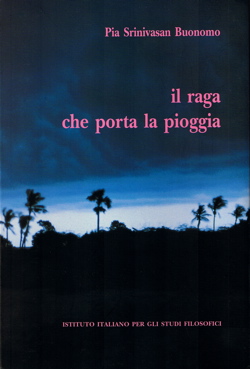
Library copies on Worldcat.org >>
Excerpt from the review by Laura Leante / 2007 Yearbook for Traditional Music
The strength and originality of this book are to be found in its lying between genres: not being an academic musicological work, or a fieldwork journal, or simply a travelogue, it fills an empty corner in the literature, in which ethnomusicologists in particular can recognize themselves and their experiences. Il raga che porta la pioggia is an extremely enjoyable work which does not require familiarity with Indian music and which will engage, at a variety of levels, a broad readership.
Excerpt from the review by Giorgio Milanetti / Istituto Italiano per gli Studi Filosofici
Being in India during the (there not so much) ‘fabulous sixties’ without being an Indian, Pia Srinivasan enjoyed the unquestionable advantage of a dispassionate eye, and at the same time suffered some of the equally unquestionable prejudices any European woman married to an Indian would have suffered forty years ago … she patiently observes, interprets, and describes.
It is this continuous, courageous, at times almost impossible work of deciphering, translating, and transmitting to her correspondents, to herself, and to us as well, the puzzling reality of ‘India’, that represents one of the most relevant qualities of this valuable book. …
Her approach to this unusually un-exotic India thus closely reminds us of the great Italian travellers of pre-colonial times.
Renata Maione
Conservatorio S. Pietro a Majella, Naples
Pia Srinivasan Buonomo‘s book is based on her letters home during a stay in India and this its epistolary nature it this that gives it a narrative and intimate tone – description, reflection, critical comments trace with success a vast section both of the country and of Indian culture.
The sensitive commingling of language both familiar and high, an incisive and comprehensive description of characters and situations mean that reading the book is something smooth, pleasant and often fascinating. And thus the charme of a culture so different from ours leads us readers too to get involved in it; the love, the acceptance, the understanding that the author shows for the traditions and the ways of life in India, her empathy, that enables her to judge in freedom from her own cultural heritage, are such that the reader too get involved in the India she describes.
The leitmotif of the book, namely her “initiation” in the Indian music, take us to discovering that there are affinities between Western music of the 20th century, in search of new forms, and the millenarian music of this Asian country. Adorno says that true “works of art… call for their interpretation”, and an element characteristic of Indian music as it is practised is precisely the “reinterpretation” of a piece by the same musician each time she/he sings or plays it, thus giving a well-known melody too an interpretation always new. And concerts are performed in the open too, so that the surrounding sounds of nature and every-day human life commingle and become concertistic – one can’t but be reminded of the trials of Cage.
And there is an element too basic to both Western and Carnatic music, an element emphasised by the many musicians Pia S.B. got in touch with, namely constant practice. “Yevvery day four hours practice pannanum” – thus a teacher in the English characteristic of Indians.
Aldo Colucciello
Anthropologist, University Naples
The choice of a book to read is always a personal affair. Like a vessel, this strange travel instrument, in an instant, leaves the fantasy world, the old reminiscenses. It takes on a life of its own, independently from ourselves. Deciding to read a book like The Raga which brings Rain was an experience that brought me to a country, India, which was the goal of my own pilgrimage. I found in it the same intensity as my own experience: the taste of the food, the strength of the smells, and, already in but a few of its words, my vivid remembrance of the Indian Sub-Continent.
I knew Mrs Pia Srinivasan Buonomo as a musician and I had the fortune to witness her performance in Naples, but I find her a brilliant writer too.
The peculiarity of this book is the epistolary style of her description of the events. Mrs Srinivasan Buonomo never forgets her origins and lives the two experiences with depth of analysis, with coherence, like an observer in the field . In fact this book is a very good piece of ethnography.
I found a wealth of information on Mrs Srinivasan Buonomo’ s area of interest, the Tamil Nadu, about music and musicians, and the relationship between the social layers in the complex caste system. [*]
The observer, in my view, reconstructs her personality on a new basis but preserves her napoletanità, becoming an operator, who does not fail in field work, unlike many anthropologists who forget empirical research and involve themselves in armchair anthropology, as seen in the Victorian Age.
My impression about this book is that Mrs Srinivasan Buonomo shares with us her Indian experiences, shows us that contact and pacific existence with other cultures is possible; the secret is to have no sense of superiority of one’s own culture over that of others. She used music as a vehicle to bridge her own personality over two cultures and this medium, often, demonstrates itself to be a real ambassador, to be able to connect with faraway places which, in reality, are very close to our own world, its sentiments.
I love reading this book, leafing through it in those moments of nostalgia for home-India, and I find it incredible how another person resonates my own feelings. Perhaps it is true that human beings respond to the same archetypal forms.
The area examined in this book is a part of India; it is a brilliant description of Madras (called Chennai now) which is different from the North of India, in its customs and on a linguistic level too. Perhaps for travelers like us this form of diversity is one of the most fascinating aspects of this country. There is no one uniform India, the Indias are many.”
Some clarifications on caste-related issues by reputed scholars >>
Carla Conti
Conservatorio S.Cecilia, Rome
In India one does not need to look for music, instead, it is music that finds us.
Music is everywhere like air, and it has the capacity to refresh all the vitality of the Indian subcontinent to which the title of this book pays homage.
What lies behind this book is an important principle of ethnomusicology I have experienced myself all through my stay in India, which requires one to be a “participant-observer” of the music, and only participation proves to be effective by sharing people’s life experiences, wearing their clothes, living in their houses, using their means of transport, taking part in their religious ceremonies.
The whole of Indian music can be found in Pia Buonomo’s book which introduces the reader into the world of the sounds that fascinated her by the end of the sixties, a world made of the sounds of nature as well as of urban sounds and the peculiar sounds of traditional musical instruments.
The author starts with the sounds of nature, such as those made by the “manikkuruvis”- musical birds singing certain kinds of ragas – or those used by frogs to communicate, which remind us of the example given by the Veda books, where a pupil repeats his teacher’s words. Then she describes the urban sounds, such as those made by the street vendors selling lemons – “Yelemiicche” – and the road traffic roar mixed up with “house” sounds.
The book culminates with the music sounds (in fact, she gives many examples of music lessons and concerts, music for theatre and dance, musical instruments, and also mentions the new phenomenon of the soundtracks of the “blockbuster” movies which have turned into the Bollywood song repertoire) and, most importantly, the author describes her discovery of Indian singing style and vinas.
As a Sanskrit saying goes, “Ranjayati iti ragah”, which means, “A thing that colours one’s mind is a raga”.
In her book Pia Buonomo recounts her encounter with the classical music of Southern India, a kaleidoscope of ragas which succeed in keeping alive its long-time history, thanks to their usage and transformation.
Let me wish the readers that Indian music can find them as soon as possible.
More about “Il raga che porta la pioggia” by Pia Srinivasan Buonomo >>
